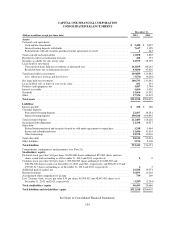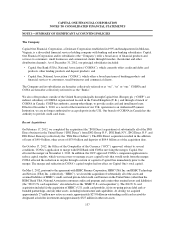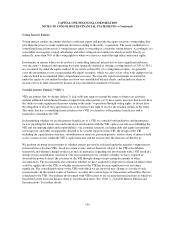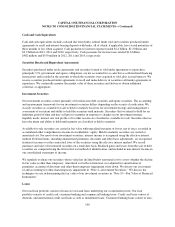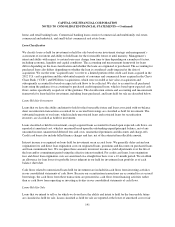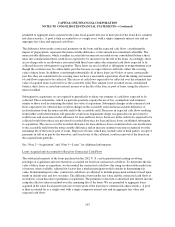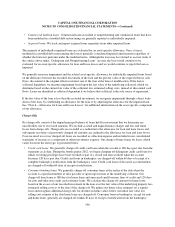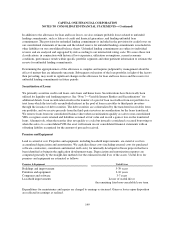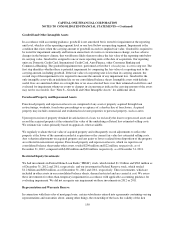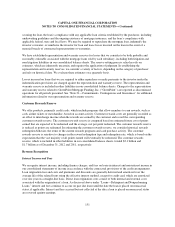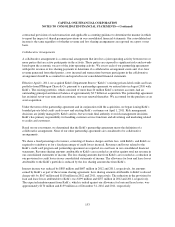Capital One 2012 Annual Report Download - page 162
Download and view the complete annual report
Please find page 162 of the 2012 Capital One annual report below. You can navigate through the pages in the report by either clicking on the pages listed below, or by using the keyword search tool below to find specific information within the annual report.
CAPITAL ONE FINANCIAL CORPORATION
NOTES TO CONSOLIDATED FINANCIAL STATEMENTS—(Continued)
permitted to aggregate loans acquired in the same fiscal quarter into one or more pools if the loans have common
risk characteristics. A pool is then accounted for as a single asset, with a single composite interest rate and an
aggregate fair value and expected cash flows.
The difference between the contractual payments on the loans and the expected cash flows, considering the
impact of prepayments, represents the nonaccretable difference, or the amount not considered collectible. The
nonaccretable difference, which is neither accreted into income nor recorded on our consolidated balance sheet,
takes into consideration future credit losses expected to be incurred over the life of the loans. Accordingly, there
are no charge-offs or an allowance associated with these loans unless the estimated cash flows expected to be
collected decrease subsequent to acquisition. These loans are not classified as delinquent or nonperforming even
though the customer may be contractually past due because we expect that we will fully collect the carrying
value of these loans. In addition, even though substantially all of these loans are 90 days or more contractually
past due, they are considered to be accruing since we have a reasonable expectation about the timing and amount
of cash flows expected to be collected. The excess of cash flows expected to be collected over the estimated fair
value of acquired loans is referred to as the accretable yield. This amount is not recorded on our consolidated
balance sheet, but is accreted into interest income over the life of the loan, or pool of loans, using the effective
interest method.
Subsequent to acquisition, we are required to periodically evaluate our estimate of cash flows expected to be
collected. These evaluations, which we perform quarterly, require the use of key assumptions and estimates
similar to those used in estimating the initial fair value at acquisition. Subsequent changes in the estimated cash
flows expected to be collected may result in changes in the accretable yield and nonaccretable difference or
reclassifications from the nonaccretable yield to the accretable yield. Decreases in expected cash flows resulting
from further credit deterioration will generally result in an impairment charge recognized in our provision for
credit losses and an increase in the allowance for loan and lease losses. Increases in the cash flows expected to be
collected would first reduce any previously recorded allowance for loan and lease losses established subsequent
to acquisition. The excess over the recorded allowance for loan and lease losses would result in a reclassification
to the accretable yield from the nonaccretable difference and an increase in interest income recognized over the
remaining life of the loan or pool of loans. Disposals of loans, which may include sales to third parties, receipt of
payments in full or in part by the borrower, and foreclosure of the collateral, result in removal of the loan from
the acquired loan portfolio.
See “Note 2—Acquisitions” and “Note 5—Loans” for additional information.
Loans Acquired and Accounted for Based on Contractual Cash Flows
The substantial majority of the loans purchased in the 2012 U. S. card acquisition had existing revolving
privileges at acquisition and were therefore accounted for based on contractual cash flows. To determine the fair
value of these loans at acquisition, we discounted the contractual cash flows due using an observable market rate
of interest, when available, adjusted for factors that a market participant would consider in determining fair
value. In determining fair value, contractual cash flows are adjusted to include prepayment estimates based upon
trends in default rates and loss severities. The difference between the fair value and the contractual cash flows is
recorded as a loan discount or premium at acquisition. The premium or discount is amortized into interest income
using the effective interest method over the remaining life of the loans. We are permitted to aggregate loans
acquired in the same fiscal quarter into one or more pools if the loans have common risk characteristics. A pool
is then accounted for as a single asset with a single composite interest rate and an aggregate fair value and
expected cash flows.
143



